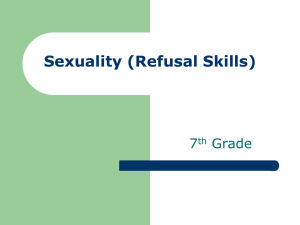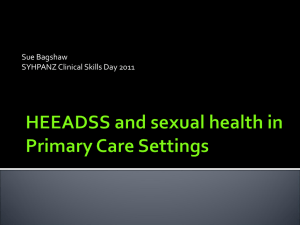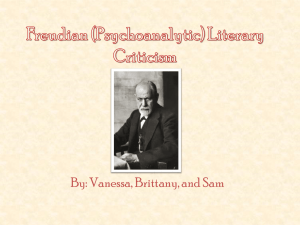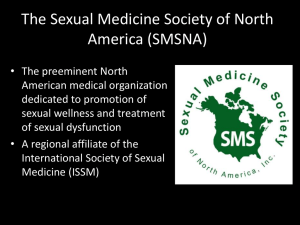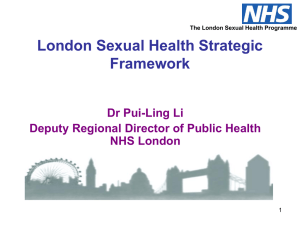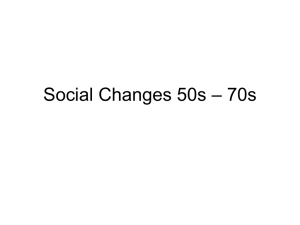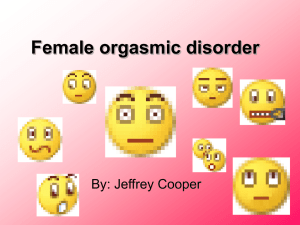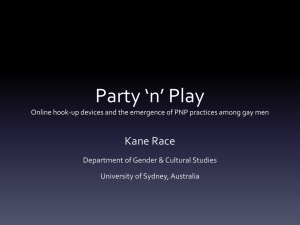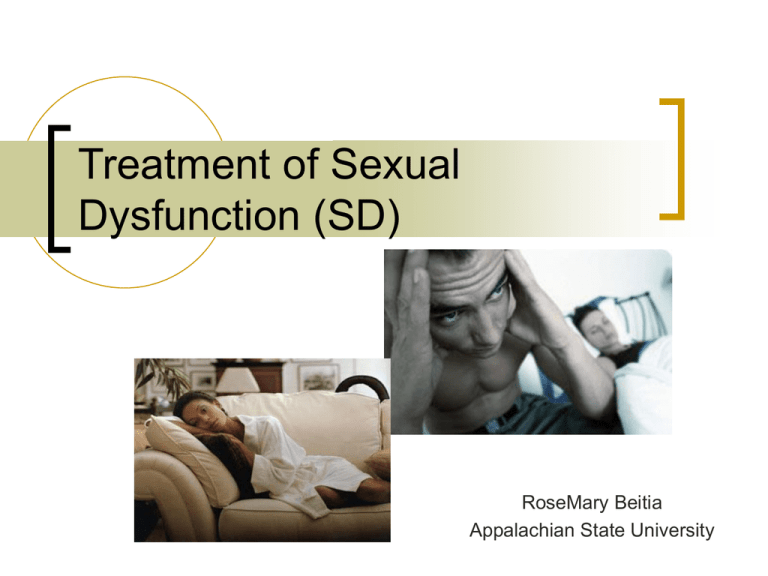
Treatment of Sexual
Dysfunction (SD)
RoseMary Beitia
Appalachian State University
Definition
“Sexual dysfunction is characterized by disturbance in sexual
desire and in the psychophysiological changes that characterize
the sexual response cycle and cause marked distress and
interpersonal difficulty” – APA 2000
This conceptualization of the “sexual response cycle” has evolved
greatly over the past half century
Original William Masters & Virginia Johnson (1966) model of the
“sexual response cycle” consisted of:
Excitement
Plateau
Orgasm
Resolution
Limited to brief intervention, long-term efficacy not substantiated,
more specialized approaches needed
(APA, 2000; McAnulty, & Burnette, 2006; Segraves, & Althof, 1998)
Sexual Response Cycle
Kaplan (1974) consisted of the following:
Desire
Excitement
Orgasm
Limited focus on physical arousal
According to systemic models the sexual response is
the result of interaction between the following 3
domains:
1.
2.
3.
Biological
Psychological
Relational
(Segraves, & Althof, 1998)
A Brief History
Rise of behavioral
techniques involving
systematic desensitization
pairing relaxation &
exposure methods
1970 1974
1900-1950
1950-1970
Psychoanalytic approach sexual problems were
linked to unresolved,
unconscious conflicts during
specific developmental
periods
Masters & Johnson
initiated a more
biopsychosocial model
consisting of physical
examinations, history of
dysfunction, education,
behavioral & cognitive
tasks, interpersonal issues;
proposed brief, problem
focused solutions
A Brief History continued
Helen Singer Kaplan’s
The New Sex Therapy
integrating M&J
approach with
psychodynamic
methods
1980 - current
1974-1980
Neo-Masters &
Johnson Era
Mid-1980’s dawned the
medicalization era; including
combined CBT &
pharmaceutical treatments; but
has not had as significant an
impact on female sexual
dysfunction
Phases of the Sexual
Response
As a function of “normal” sexual responding:
Desire: Defined by an interest in being sexual and in having
sexual relations by oneself or with an appropriate partner
Arousal: Refers to the physiological, cognitive & affective
changes that serve to prepare an individual for sexual activity
(e.g., penile tumescence and erection, vaginal lubrication,
expansion & swelling of vulva)
Orgasm: Refers to climatic phase with release of sexual tension
and rhythmic contraction of the perineal muscles and
reproductive organs:
Sense of ejaculatory inevitability in males followed by ejaculation
Contractions in the outer third of the vagina
Resolution: Refers to sense of muscular relaxation and general
well-being; men are physiologically refractor while women may
respond to further stimulation
(APA, 2000)
Male Sexual Response
Female Sexual
Response
Physiological indicators of arousal
Vasocongestion in the pelvis
Vaginal lubrication
Labia minora may darken
Clitoris hardens leading the
vaginal hood (prepuce of clit) to
appear enlarged
Causing the vulva to lengthen
and widen
Areola hardens & nipples
become erect
Breast tumescence
Female Sexual Response
Experts on female
anatomy contend that
there is an area in the
outer third of the vagina,
also responsible for
orgasm, the Grafenberg
or the G-spot
Located in the front of the
body, 2” from entrance of
the vagina
Clitoral vs. vaginal
orgasm??
DSM-TR Diagnoses
*Focus of the presentation
Sexual desire disorders
Sexual arousal disorders
Hypoactive Sexual Desire Disorder (HSDD); Male/Female
Sexual Aversion Disorder (SAD)
Female Sexual Arousal Disorder (FSAD)
Male Erectile Disorder
Orgasmic disorders
Female Orgasmic Disorder (Inhibited Female Orgasm)
Male Orgasmic Disorder (Inhibited Male Orgasm)
Premature Ejaculation
(APA, 2000)
DSM-TR Diagnoses cont’d
Sexual pain disorders
Sexual Dysfunction Due to GM Condition
Substance-Induced Sexual Dysfunction
Dyspareunia (not due to GM condition)
Vaginismus (not due to GM condition)
With impaired desire
With impaired arousal
With impaired orgasm
With sexual pain
With onset during intoxication
Sexual Dysfunction Not Otherwise Specified (NOS)
(APA, 2000)
Subtypes
Indicate onset:
Context:
Lifelong Type
Acquired Types
Generalized Type
Situational Type
Etiological Factors:
Due to Psychological Factors
Due to Combined Factors
(APA, 2000)
Other Sexual Dysfunctions
Paraphilias
Exhibitionism
Fetishism
Frotteurism
Pedophilia
Sexual Masochism
Sexual Sadism
Transvestic Fetishism
Voyeurism
Gender Identity Disorders
NOS
Dysphoria
(APA, 2000)
Desire Disorders
Hypoactive Sexual Desire Disorder (HSDD)
DSM-IV Criteria:
Persistently or recurrently deficient (or absent) sexual
fantasies and desire for sexual activity
Not better accounted for by Axis I disorder (e.g.,
depression, anxiety) and not due to physiological effects of
a substance (e.g., alcohol, prescription medications)
Sexual Aversion Disorder (SAD)
DSM-IV Criteria :
Persistent or recurrent extreme aversion to, and
avoidance of, all (or almost all) genital sexual contact with
a sexual partner.
Not better accounted for by Axis I (e.g., PTSD)
Desire Disorders
General Understanding:
Highly comorbid (e.g., depression, anxiety, GMCs)
Quantified in terms of sex interest, rather than actual sexual behavior
Clinical Presentation:
Negative/ indifferent affect
“Take it or leave it” attitude
Lack of attraction to partner
May be associated with trauma
Avoidance of sexual activity
Disparity in relationship member desire
Possess social expectations of “normal” sexual behavior
When avoidance is accompanied by extreme aversion of genitals, SAD diagnoses may
be more accurate
Onset
Disorder present in all situations (e.g., global vs. specific)
“Treatment resistent”
(Wincze,& Carey, 2001)
Arousal Disorders
Male Erectile Disorder
DSM-IV Criteria :
Persistent or recurrent inability to attain, or to maintain
until completion of sexual activity, an adequate erection
Not better accounted for by Axis I disorder, substances or
GMC
Female Sexual Arousal Disorder (FSAD)
DSM-IV Criteria:
Persistent or recurrent inability to attain, or to maintain
until completion of sexual activity, an adequate lubricationswelling response of sexual excitement
Not better accounted for by Axis I, substances, or GMC
Arousal Disorders
General Understanding:
Absence of or reduced arousal response
Components:
Physiological (e.g., erectile dysfunction, vaginal dryness)
Cognitive (e.g., attention to erotic stimuli, cues, fantasies)
Affective (e.g., subjective sense of excitement, novelty, romance)
Anxiety negatively correlated with affective & cognitive
components; although physiological (genital) responses may
be observed
Differential diagnosis between diminished subjective arousal
(affective & cognitive) and low sexual desire
(Wincze,& Carey, 2001)
Arousal Disorders
Clinical Presentation:
Factors influencing Male Erectile Disorder
Physiological: partial or complete inability to attain, or maintain
an erection sufficient for intromission and sexual activity
Some men report full erection potential during non-coital
stimulation (e.g., masturbation, nocturnally during REM sleep)
Psychosocial:
Performance anxiety
Embarrassment
Depression, increased suicidality
Negative affect in presence of erotic stimulation
Sensitive to feelings of demand
Underestimate erectile response
Result of chronic & acute stress
(Wincze,& Carey, 2001)
Arousal Disorders
Clinical Presentation:
Factors influencing Female Sexual Arousal Disorder (FSAD)
Physiological:
Psychosocial:
lack of responsiveness to sexual stimulation (e.g., vaginal lubrication,
swelling of vulva)
Anxiety, worry, fear
Depression
Low self esteem
Performance anxiety
Shame
Sexual abuse
Marital difficulties
Poor communication with partner
Negative affect toward sex during adolescence
Inaccurate subjective appraisal of arousal
Reaction milder than males with ED
(Wincze,& Carey, 2001)
Orgasmic Disorders in Men
Orgasmic Disorder (Inhibited Male Orgasm)
DSM-IV Criteria:
Persistent or recurrent delay in, or absence of, orgasm following a
normal sexual excitement phase during sexual activity that the
clinician, taking into account the person’s age, judges to be
adequate in focus, intensity, and duration
Not better explained by Axis I, substance, GMC
Premature Ejaculation
DSM-IV Criteria:
Persistent or recurrent ejaculation with minimal sexual stimulation
before, on, or shortly after penetration and before the person
wishes it. The clinician must take into account factors affecting
duration of excitement phase, such as age, novelty of new partner
and sexual situation and recent frequency of sexual activity
Not due exclusively to direct effects of substance (e.g., opioid
withdrawal)
Orgasmic Disorders in Men
Male Orgasmic Disorder
Also referred to as “retarded ejaculation”
Refers to physiological inability to achieve orgasm despite desire,
arousal & stimulation
Ejaculation has 3 stages:
Emission
Bladder neck closure
Ejaculation proper
Not “retrograde ejaculation”
Premature Ejaculation (PE)
Three core components:
1.
2.
3.
Perception of how long it takes for the “average” man to ejaculate
varies between 7-14 minutes
Short ejaculatory latency
Lack of control over ejaculation
Lack of sexual satisfaction
Vary across countries, Germans, 7 mins; Americans, 14 mins
Most commonly used index of PE is intravaginal ejaculatory latency
time (IELT) from 1-5 minutes
(Wincze,& Carey, 2001; DeRogatis, & Burnett, 2007)
Orgasmic Disorder in Women
Female Orgasmic Disorder
DSM-IV Criteria:
Persistent or recurrent delay in, or absence of,
orgasm following a normal sexual excitement
phase. Women exhibit wide variability in type of
stimulation that triggers orgasm.
Diagnosis based on clinician judgment that
orgasmic capacity is less than reasonable given
age, sexual experience, adequacy of sexual
stimulation
Not better accounted for by Axis I, substance,
GMC
Orgasmic Disorders in Men &
Women
General Understanding:
Clients present with concerns about absence of coital, multiple
or synchronous orgasms
Continuum model from mild to extreme
Clients tend to compare themselves to unrealistic ideals,
creating anxiety and perpetuating dysfunction
“Maybe I’m just dead down there”
Media influence of patient perceptions emphasizing importance
of psychoeducation (e.g., myths of sexual encounter, male &
female sexuality)
*Absence of orgasm during intercourse without direct clitoral
stimulation is not uncommon in women
(Wincze,& Carey, 2001)
Orgasmic Disorders
Clinical Presentation:
Factors Influencing Female Orgasmic Disorder
Physiological:
Psychosocial:
Sexual knowledge
Levels of sexual desire
Sexual fantasizing
Sexual attitude; confidence
Religious/cultural beliefs
Body image
Self-esteem
Social norms can heavily influence orgasmic function
Inability to achieve orgasm
Morokoff (1978) found that birth during the 20th century was related to
higher frequency of orgasm
Lifelong or acquired
(Wincze,& Carey, 2001)
Prevalence
Many challenges to estimating the prevalence of
sexual disorders
Methodological issues
Utilizing clinical verses non-clinical criteria
Vague diagnostic descriptions (e.g., definition of premature
ejaculation, low sexual desire v interest)
Lack of universal/agreed upon diagnostic system
Sexual problem must be perceived as bad
Effects of social norms
Availability of regular sex partner
Selection bias in samples (formerly patients presented to
hospitals, clinics, GPs)
Comorbidity (sexual problem may be secondary to primary
psychological or medical issue)
Prevalence
Male SD
Data
Set
NHSLS
N=1,410
N=1,749
HSDD ED
15%
10%
Female SD
PE/
Anorgasm
8%*
orgasm
(age 18-59)
GSSAB
N=27,000
--
10% 14%-30%
* PE
(age 40-80)
Other data
sets
3%55%
10%33%
--
HSDD
FSAD Anorgasm
22%;
32%
lack
interest
14%
29%
achieve
frequent
orgasm
24%43%
lack
interest
--
--
10%64%
8%28%
39% pop. of
Vietnamese
25% Dunn,
2004
Totals
M: 31%
W: 43%
Prevalence & Comorbidity
HSDD
For men & women concurrence rates of HSDD with other SDs is an estimated
41% and 47%
*Poor dyadic adjustment most consistently associated with HSDD
WISoH&S data investigated menopause & SD in women
Low sexual desire (LSD) was 16% prevalent in premenopausal women
29% in surgically menopausal 20-49
46% in surgically menopausal 50-70
42% natural menopause
Arousal Disorders
Overall, prevalence range of ED is 10-20%
Presence of ED increases with age and poor medical status
IN HPFS survey data, ED increased from 33% to 61% in men above 70
Orgasmic Disorders
Prevalence of PE is approximately 30% across age groups (GSSAB)
Highest rates reported in Southeast Asia (30.5%) & lowest in Middle East
(12.4%)
Found to be significantly correlated with Social Phobia
Other disorders
Prevalence of pain disorders 1%-21% in women
(DeRogatis, et al., 2007; Graziottin, 2007)
Prevalence & Comorbidity
High rates of comorbidity with anxiety & depression
General medical conditions associated with SD
Loss of libido or decreased sexual desire has been
reported in up to 72% of patients with unipolar depression;
77% with bipolar
Men: diabetes, cardiovascular disorder, hypertension,
dyslipidemia, obesity, smoking, prostate disorders
Women: chronic illness, poor general health status, such
as diabetes, breast cancer, lower urinary tract infection,
surgical removal of ovaries, multiple sclerosis
Risk of SD is increased by smoking and excessive
alcohol use; GMC may further increase risk
SD consistently reported in patients taking SSRIs
Estimates range from 10%-65%
(DeRogatis, et al., 2007)
Specific Etiologies
Common factors of low sexual desire in men & women:
Boredom
Lack of physical attraction to partner
Negative or faulty attitudes
Dissatisfaction with partner sexual activity
History of sexual abuse
Common factors of arousal disorders in men & women:
Health status
Performance anxiety
Negative affect:
Organic theories of PE
Suppression and expression of anger correlated with higher rates of ED
Penile hypersensitivity - lower ejaculatory threshold, reached more rapidly
Hyperexcitability ejaculatory reflex – faster emission phase
Genetic predisposition
Central 5-HT receptor sensitivity – lower 5-HT transmission, receptor
hyposensitivity
Religion & culture may influence sexual functioning, all three stages
(Metz, & Pryor, 2000; Wincze, Bach, & Blume, 2008; Wincze,& Carey, 2001)
Etiology
A Systemic Perspective
According to the systemic and “biopsychosocial”
model sexual response is the result of interaction
between the following 3 domains:
1.
2.
3.
Biological – physiological mechanism that prepare and
enable genital response
Psychological – affective and cognitive predispositions
and interpretations that sustain response
Relational – dyadic interactions which promote intimacy,
meaning and mutually satisfying outcomes
*Multifactorial contribution of biological,
psychological, psychophysiological and
interpersonal factors are often difficult to distinguish
Etiology as a Function of Risk
Factors
Causes are multiply determined
Risk factors
Age
Overall, SDs increase with age
PE decreases with age
Inverse relationship between age & distress brought on by SD
Health status
65% American women (20-29 yrs) LSD w/ distress; 22% (60-70yrs) w/o distress
67% European women (20-29yrs) LSD w/ distress; 37% (60-70yrs) w/o distress
Genetic inheritance (Type 1 diabetes)
Hormone deficiency
Lifestyle (poor diet, low activity level)
Excessive substance use
Dyadic adjustment
Decreased sexual knowledge
CSA
Predisposing factors (genetics) X Precipitating factors (coping w/
stressful life events) X Maintaining Factors (poor dyadic
adjustment) = Diathesis Stress (DeRogatis, et al., 2007; Wincze,& Carey, 2001)
Special Considerations
Sexual Minorities
Factors influencing impaired sexuality in homosexuals
Psychological issues accompanying choice to “pass” as straight
Gender identity issues
Identity & “coming out” problems
Sexual expression
Gay male community engaged in controversy over sex
Emerging sexual scene for lesbians influenced more by gay men
than heterosexual females
Barebackers begun backlash against promotion of safe sex, labeling
campaign members “condom nazis”
Nonmonogamy
High frequency of desire discrepancy/inhibited sexual desire in
lesbians & sexual script issues
“Sex addiction”
(Leiblum, & Rosen, 2000)
Treatment Approaches
Sex Therapy (CBT + Master’s &
Johnson)
Pharmacotherapy & Medical Devices
A Systemic Approach
Bibliotherapy
Sex Therapy
Treatment length
Traditional Master’s & Johnson
Daily sessions 2- or 3-week period (up to 15 sessions)
Current CBT therapy course may vary based on
client/couple
Some clients benefit from only 3-4 sessions of
psychoeducation
Otherwise, treatment is once a week for 10-12 weeks
Couples strongly encouraged to participate together
Assessment : Sessions 1-3
Goals:
Establish rapport
Obtain a general description of sexual problem or problems
Discuss life concerns and current stressors
Determine nature & causal factors:
Lifelong vs. acquired
Generalized vs. situational
Due to psychological or combined factors
Obtain general psychosocial history
Determine whether sex therapy is appropriate
Therapist must remain aware of process concerns and how they affect
relationship building
Are you comfortable addressing sexual issues?
Differences between client & therapist (e.g., age, gender)
Maintain firmly established boundaries
Important to maintain objectivity and remain sensitive with matters of
religion or culture (e.g., devout Catholic with concerns about birth control)
Assessment : Sessions 1-3
Sample structure:
1. **Begin with nonthreatening demographics (e.g., age,
employment & marital status)
Set up safe and comfortable environment
Individual/couple format
Assess what partners are comfortable communicating with
partner present
2. Continue with open-ended questions while keeping the
client directed on presenting concern
3. Obtain a psychosocial & sexual history
Family structure, orientation
Assess for childhood abuse or trauma
Assess history and current peer relationship status, self
esteem, dating experiences, body image
Current sexual functioning
Assessment : Sessions 1-3
4. Obtain a brief medical history (e.g., childhood diseases, surgery,
medical care)
Current Health Status
General Medical Conditions associated with SDs
Diet
Exercise
Maladaptive lifestyle habits (e.g., smoking, drinking)
Hormonal disturbance (e.g., menopause)
Abnormally low testosterone levels (e.g., tx for prostate cancer)
Metabolic syndromes (e.g., diabetes, hypertension, hyperlipidemia,
obesity)
Glaucoma
Vascular conditions (e.g., CHD, ischemic heart disease, angina)
Epilepsy
Assess exposure to STDs
* In the event of a medical consult therapist may act as a liaison
Assessment : Sessions 1-3
5. Be sensitive to any potential covert issues
6. Provide client with a second opportunity to share concerns
7. When working with couples, at this point you would interview the
second partner individually
Therapists commonly have each partner complete assessment
measures while interviewing the other
Allows therapist to develop conceptualization of independent partner
difficulties
8. Later the therapist will reunite the couple and review assessment
measure outcome
*Important to address dyadic sexual adjustment
9. *Integration of information
Acquired vs. lifelong
Determine appropriateness of sex therapy
10. *Develop goals reasonable with client/couple
Avoid goals related to performance (e.g., firm erections)
Couple Distress
SD sometimes secondary to couple distress
Treatment may be postponed depending on
severity
Accurate assessment of causal sequence of
couple distress & SD
When couple distress is the cause of SD,
resolution of these problems take precedent
Determine SD treatment appropriateness
Make referral to marriage counselor,
individual therapist, physician, etc.
(Wincze, Bach, & Blume, 2008)
Wincze & Barlow Model
(1997)
Medical
Indications
Medical
Stabilization
Minimal Couple
Distress
Medical
Evaluation
Psychosocial
Evaluation
Assessment
& Integration
of Information
One partner
Sexual
problem
Individual Sex
Therapy
Possible
Couple Therapy
One partner
Psychological
problem
Individual
Psychotherapy
Possible
Couple Therapy
Significant
Couple
Distress
Couple
Therapy
Substance
Abuse
Substance
Abuse Tx
Couple Sex
Problems
Only
Possible
Couple Therapy
Sex Therapy
Assessment Measures
Indices of Sexuality & Sexual Functioning:
Men
International Index of Erectile Function (15 item)
Erection Hardness Scale (1 item)
RigiScan
Women
Brief Index of Sexual Functioning for Women (BISF-W)
Derogratis Sexual Functioning Inventory (DSFI)
Sexual Self-Efficacy Scale for Female Functioning (SSES-F)
Female Sexual Function Index (FSFI)
Profile of Female of Sexual Function (PFSF)
Structured Clinical Interview for Gynecologists Caring for
Women With Sexual Dysfunction
Photoplethysmograph
Assessments Measures
Both Men & Women:
Indices of Psychosocial Functioning
Sexual Desire Inventory
Cues for Sexual Desire Scale (CSDS)
Dyadic Adjustment Scale (DAS)
Inventory of Dyadic Heterosexual Preferences (IDHP)
Sexual Interaction Inventory
Golombok Rust Inventory of Sexual Satisfaction (GRISS)
Sexual Opinion Survey (SOS)
Sexual event logs
BDI
BAI
Symptom Checklist 90; Brief Symptom Inventory (53-item
abbreviated version)
Suicide risk assessment
Indices of Health Status
Medical History Form
Psycho-“sex”-education
Topics to be addressed:
1. Anatomy (diagrams, models)
2. Physiology
3. Unrealistic expectations of self & sexual
encounter
4. Address myths of sexuality
Level of detail necessary for education may vary
based on client
Continual throughout course of therapy
(Wincze, & Carey; Wincze, Bach, & Blume, 2008)
Myths of Sexuality
Myths of male sexuality
1.
A real man is not into sissy stuff like
feelings and communicating.
A real man performs in sex.
Sex is centered around a hard penis and
what is done with it.
Real men do not have sexual problems
Focusing more intensely on one’s erection
is the best way to get an erection
2.
3.
4.
5.
Myths of female sexuality
1.
Sex is only for women under 30.
All women have multiple orgasms.
Pregnancy and delivery reduces women’s
responsiveness.
If a woman cannot have an orgasm quickly and
easily, there is something wrong with her
Feminine women do not initiate sex or become wild
and unrestrained during sex.
2.
3.
4.
5.
Myths of Sexuality cont’d
1.
2.
3.
4.
5.
6.
Myths of Male & Female Sexuality
We are liberated and comfortable with sex.
All touching is sexual or should lead to sex.
Sex is intercourse.
Good sex requires orgasm.
People in love should automatically know what their partners
desire.
Fantasizing about someone else means a person is not
happy with what he/she has.
**We are all susceptible to these false assumptions and
seemingly silly generalizations about human sexuality.
Universal CBT Tools
1. Cognitive Restructuring
Goals:
Strategies to challenging negative cognitions:
1.
2.
3.
Identify cognitions and beliefs about sexual encounter
Normalize feelings of anxiety, frustration, disappointment
Identify possible precipitating factor leading to acquired vs. lifelong SD
Challenge negative thoughts
Provide education
Stick to the facts
Decatastrophize
Useful across various SDs & integrated throughout treatment
course
Universal CBT Tools
2. Stimulus Control
Goals:
Method involves manipulation of environmental factors to
facilitate a given behavior or outcome
Creating conditions conductive to healthy sexual functioning
Methods:
1.
Generating lists of conditions or factors which positively &
negatively affect arousal, such as:
2.
Setting
Mood (self & partner)
Atmosphere
Performance concerns
Faulty beliefs
*Maximize positive factors & minimize negative factors
Sex Therapy
Desire Disorders
Primary Goals & Strategies:
Communication Training
Cognitive Restructuring
Education
Behavioral Intervention
Sex Therapy
Desire Disorders
Integration of Cognitive, Behavioral, Systemic Therapy
Stage 1: Affectual Awareness
Becoming aware of neg. attitudes/beliefs about sex and/or
partner
Create a set of lists (at least 5 items per list)
1.
2.
3.
Benefits for lower drive individual gaining a higher level of sexual
desire
Benefits for relationship
Risks/costs of increasing sexual desire to self & relationship
Helps therapist & client gain understanding of:
Explore fears of gaining sexual desire
Influence of low desire on individual identity & within relationship
Therapist may also explore emotions related to “fear” lists
Role-play
Sex Therapy
Desire Disorders
Stage 2: Insight and Understanding
Therapist explains multicausality of SD
Clients consider initiating and maintaining causes of
low sexual desire
Asked to identify common individual factors
Consider power imbalance in relationship
Stage 3: Cognitive and Systemic Therapy
Therapist and clients consider how negative thoughts
and beliefs mediate low sexual desire
Develop healthy coping mechanisms
Sex Therapy
Desire Disorders
Stage 4: Behavioral Interventions
Encourage engagement in more simply affectionate behavior
“Baby steps”
Removes pressure created by performance anxiety
Mutually enjoyable activities (e.g., hugging, kissing, etc)
Graduate to more sexually based activities (e.g., genital
stimulation, intercourse)
Role-play how partner may enjoy love-making
Systematic desensitization has shown effectiveness in treating sexual
aversion & pain disorders
Client constructs fear hierarchy (10-15) activities
Rate from most to least anxiety-provoking on a 0-8 scale (e.g.,
8=intercourse, 1=watching video of sexual activity clothed)
Rate each item in terms of fear & avoidance
Exposure
Sex Therapy
Arousal Disorders
Primary Strategies:
Initial phase protocol, interviews and assessment
*Medical examinations may be especially important for addressing
arousal & orgasmic disorders
Education, assessment of beliefs about sex & sexual ability
Cognitive Restructuring
Behavioral intervention
Behavioral Techniques:
Sensate Focus: a behavioral technique useful in most SDs;
particularly useful with arousal disorders
Therapist clearly explains goals and activities involved.
Primary Objectives:
1.
2.
3.
Lessen and remove performance anxiety
Draw attention to & augment pleasurable sensations (sexual/nonsexual)
Encourage couple to draw pleasure from various forms of stimulation
Sex Therapy
Arousal Disorders
Sensate Focus:
Series of homework assignments
practiced 1-3 times between therapy sessions
15-30 minutes per exercise
*Couple agrees not to engage in sexual intercourse
(unless instructed) throughout this course of therapy
Sample series of assignments
Assignment 1: Each partner gives the other a massage while
clothed. Clients are instructed only to enjoy each others
company, removing the pressure to become aroused or
perform for the other partner.
Assignment 2: Each partner gives the other a massage while
nude with genital contact. Partners gently communicate likes
and dislikes yet the goal is still not to become aroused only
enjoy each other company.
Sex Therapy
Arousal Disorders
Sensate Focus:
Assignment 3: Repeat assignment 2.
Assignment 4: Each partner gives the other a massage
while nude with genital contact. The partners continue to
practice giving and taking feedback. If at any time the
partners become aroused (such as in ED) the therapist
may instruct the female partner to allow the male’s penis to
become soft before resuming the exercise. Again, the
focus the exercises are not to become aroused.
Assignment 5 & 6: Repeat Assignment 4
Sex Therapy
Arousal Disorders
Sensate Focus:
Assignment 7: The couple engages in sexual activity
that includes penetration without thrusting and attend to
sensations
Assignment 8: The couple engages in sexual activity
that includes mild thrusting and attend to sensations.
Assignment 9: The therapist lifts the ban on sexual
intercourse
Other Behavioral Interventions:
Relaxation
Systematic desensitization
Sex Therapy
Orgasmic disorders
Male & Female Orgasmic Disorder
Education
Encourage client to adopt realistic expectations
Encourage comfort with body and sexual desires
Cognitive & Behavioral Techniques
Construct lists of good and bad sexual activity interests
Encourage client to read magazines, sexual explicit
videos, art, etc; material utilized to create fantasies
Assign self-stimulation exercises, gradually progress in
terms of commitment, sensitivity
Daily, approx. 10-20 minutes depending on exercise
Sex Therapy
Orgasmic disorders
Sample list of exercises:
1.
2.
3.
4.
5.
6.
Client views his/her body nude in the mirror
Client views his/her genitals nude in the mirror
Client rubs/stimulates non-genital areas
Client stimulates genitals
Client repeats previous exercises until comfortable
Self-stimulation fantasies
Client shares discoveries with partner (e.g.,
mutual masturbation, fantasy role play)
Relaxation exercises
Sex Therapy
Orgasmic Disorders
Premature Ejaculation
Behavioral Techniques:
1. Stop-and-start method (Semans,1957)
Goal: Assist client to recognize pre-ejaculatory response and prevent it
Involves stimulation of penis until sensation of “premonitory to ejaculation”
Stimulation stopped, until sensation ceases, then reapplied
2. Masters & Johnson “Squeeze Technique” (1970)
Goal: Prolong physiological ejaculatory response
When man feels ejaculatory sensation, he/partner squeeze the ridge of the
penis with two fingers and his thumb below the head of his penis and holds
firmly (approx. 10 seconds or until partially loses erection)
Used before penetration or during intercourse (withdrawal of penis)
Technique can be used multiple times during a single sexual encounter
Then graduates to intercourse without motion & full intercourse
“Quiet Vagina”
*Pitfalls: Not successful in the long-term
Sex Therapy
Orgasmic Disorders
Premature Ejaculation
3. Vary coital position
Female superior coital position & lateral coital position
4. Continue intercourse as long as possible after ejaculation
Ejaculation does not signal end of intercourse
5. Continue sexual activity after coitus is no longer possible
Ejaculation does not signal end of sexual activity
Less emphasis placed on performance, reducing anxiety
and lengthening IELT
Pharmacological & Medical
Devices
May be a helpful adjunct to psychotherapy or alone
Desire & Arousal
Men
Women:
Hormone treatment (estrogen, androgens)
Buspar
Provestra
Other herbal supplements with mild effects (e.g., yohimbine, ginkgo bilboa,
DHEA, ginseng)
Ejaculatory Inhibition
Viagra, Levitra, Cialis
Topical vasodilators (aminophylline)
Phosphodiesterase inhibitors (PDEI); udenafil, avanafil
Vaccum and constriction devices
SSRIs (Dapoxetine)
Clomipramine (Anavfil)
PDEIs
MAOIs, TCAs, SSRIs, antipsychotics and other dopaminergic
antagonists having been implicated as causes of SD
Buspar is mildly effective in counteracting these effects
Pharmacological Treatment
Limitations:
These interventions focus primarily
on restoring physiological sexual
responses
Lingering concerns:
Couple communication
Negative attitudes toward sex
Negative attitudes toward partner
Inaccurate beliefs about sex
Comorbidity
What is the primary diagnosis?
Challenges of Therapy
Many clients become discouraged or impatient due to:
Self-critical nature
Faulty attribute for SDs
Devaluing actual sexual response
Ignorance of process
Time urgency
Unrealistic expectations
Religious or cultural opposition to therapy (e.g.,
masturbation)
Compliance with HW assignments
Preference for pharmacotherapy alone
Noncompliance with medications (e.g., SSRIs for PE)
“Rolling with Resistance”
Encourage realistic self-assessment, expectations
Review accomplishments
Encourage communication of specific concerns to partner or
therapist
Encourage self-management:
Give specific instructions
Model or role-play techniques in session
Discuss how and when HW should be undertaken
Know the client’s medication schedule
Revisit cognitive distortions based on myths or false beliefs
Address resistance gently but directly
Advocate for client
*Stay aware of personal process issues in therapist
Are you becoming frustrated with a client?
Systemic Approach
David Schnarch, “Constructing the Sexual Crucible” (1997)
Sexual-marital therapy
Emphasize differentiation as the “central drive wheel” of
human relationships
Therapeutic focus directed at maximizing each partner’s
individual level of differentiation and facilitating greater
intimacy through self-differentiation
Goals:
Self-confrontation
Self-validation
Self-soothing
Emotional resilience through tolerance
Systemic Approach
Duration of treatment
Intensive format, 4 daily 3-hr sessions
Structure of treatment
Individualized content to each case (e.g., dependent on nature of
“gridlock”)
May incorporates sensate focus exercises but emphasizes emotion
connection & tolerance of partner
No bans on sex, physical stimulation and encouragement of fantasizing
Session 1:
During initial interview assess cognitions, beliefs, emotions & relational
patterns regarding sex
“Devil’s pact” – identify nature of high and low desire partner
discontentment
Validating each client’s concerns; working from a differentiation standpoint
Encourages high desire client to assume low desire client standpoint
Low desire client becomes anxious, due to high desire client’s lessen reactivity
Begin addressing issue at a deeper level setting stage for treatment
Systemic Approach
Session 2:
Refining the accuracy of the “lens”
Reframe, client or therapist driven
Into the crucible
Continuing with differentiation technique
Preface confrontation with validating statements “I am addressing the best in
you”
Construction of the crucible
Piecing together sexual history & individual histories of clients
Session 3:
Establishing the elicitation window
Involves tracking sexual patterns and meanings on current and historical
levels
Setting the stage for client differentiation
Focusing on emotional connections
Continued cognitive restructuring like exercises (e.g., list writing)
“hugging until relaxed” exercise
Systemic Approach
Session 4:
Continued resolution of power dynamics between high and low desire client
Both high & low level desire client differentiate with of self-confrontation and selfsoothing
Seeing one-self through sex
Clients exhibit tolerance of one another’s faults and inevitability of gridlock in marriage
Therapist may continually confront clients with basis of presenting problem
Observe level of differentiation
Termination
Clients & therapists process benefits, likes & difficulties
*Most suitable for multiple sexual & nonsexual issues due to integration of sex
therapy, couple therapy, & individual therapy
Also effective with well-functioning couples interested in increasing intimacy,
passion, desire
Bibliotherapy
Treatment for mental & physical health problems in
which written material plays a central role
Applied within treatment formats with minimal or absent
therapist contact (e.g., self-help manuals, brief skills
training, education)
Merits:
Cost efficiency, may be performed without therapist facilitation
May be a successful adjunct to behavioral sex therapies
Meta-analyses suggest SD is amenable to bibliotherapy over
pharmacological approaches (e.g., yohimbine)
Effect sizes .5-1.8
van Lankveld (1998) average ES = .68
Taking responsibility for self-improvement can enhance
mastery experiences & SE
Primarily successful with orgasmic disorders
(van Lankveld, 1998)
Bibliotherapy
Drawbacks:
Bibliotherapies reflect direct-practice approach of M&J
not CBT formats
Positive long-term outcomes not substantiated
Research & materials available limited to orgasmic
dysfunctions
Greater likelihood of non-compliance
E.g., Lopiccolo, & Heiman (1976) Becoming
orgasmic: A sexual growth program for women,
Focus International
23 hour video, workbook following exercises
(van Lankveld, 1998)
Rigiscan
The RigiScan, an instrument used to measure continuous
penile tumescence and rigidity. It has two loops, one to be
placed around the base of the penis and the other towards
the tip, which tighten every fifteen or thirty seconds. The
recording unit can be strapped around the waist or thigh.
Back to slide

